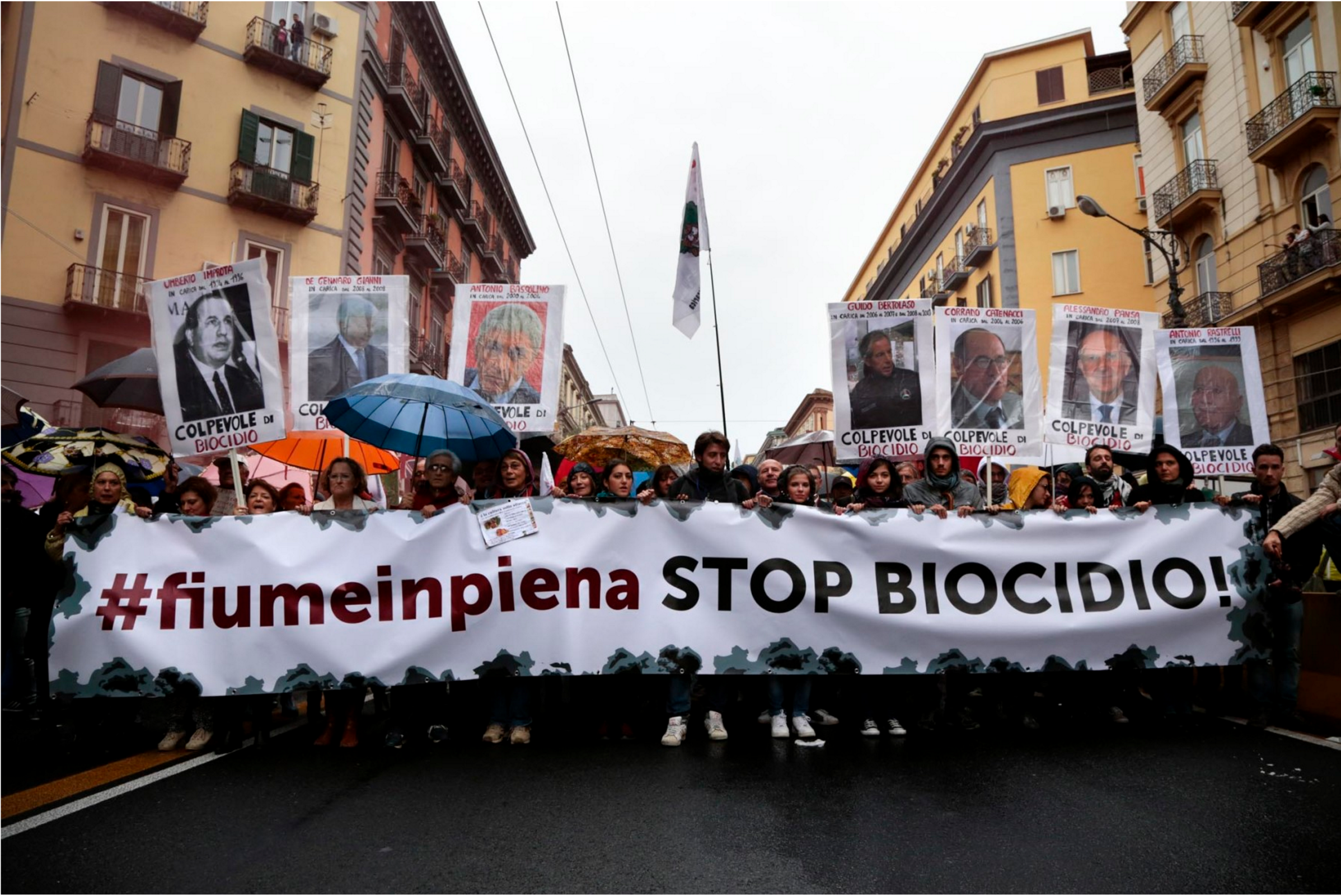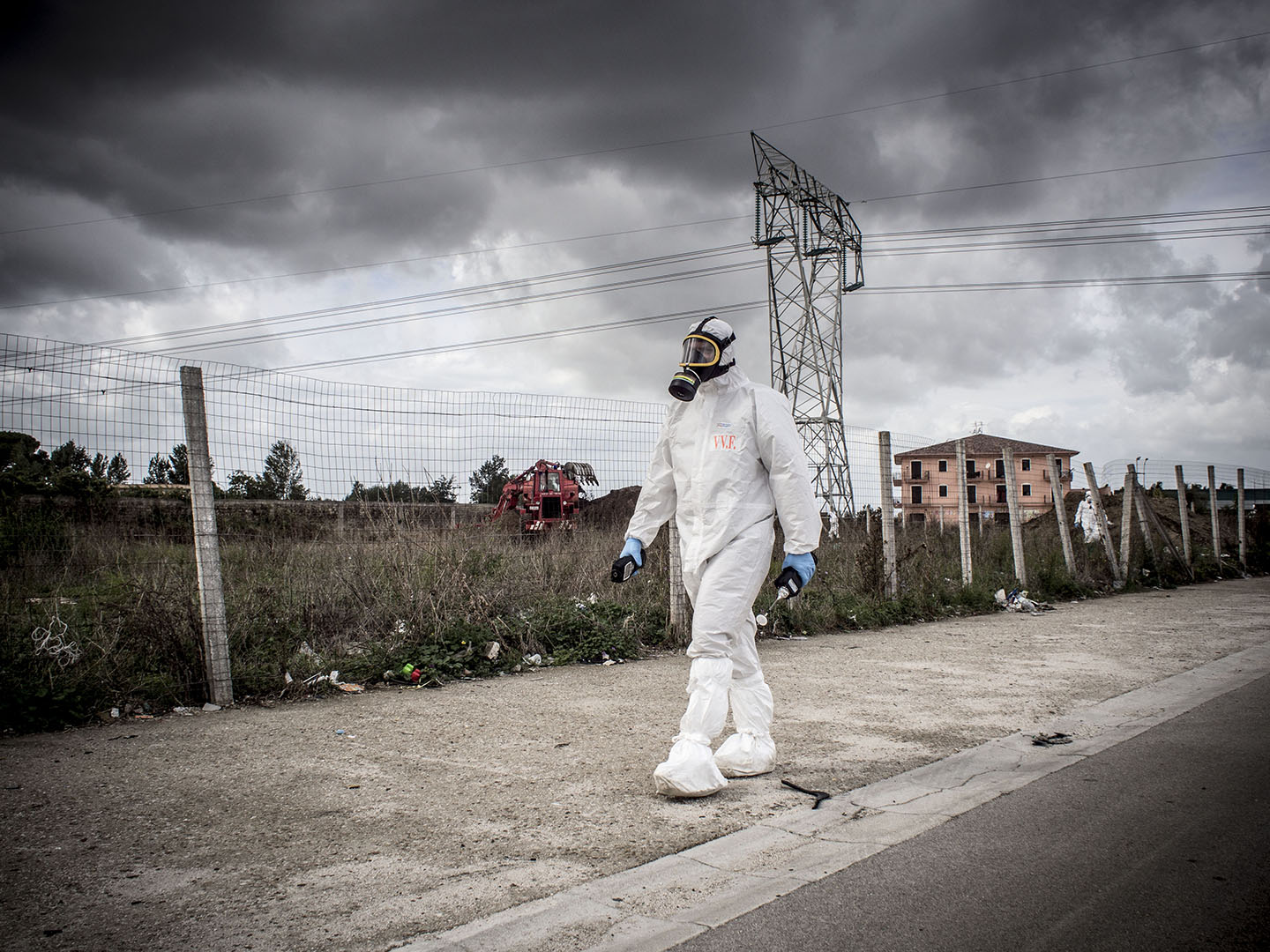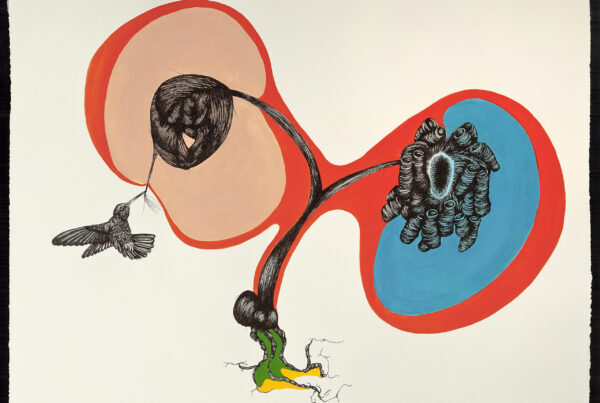Illegal economic practices are often labeled as aberrations of the market logic, but few realize their role in sustaining capitalist accumulation and power hierarchies. Uncovering the drivers of illegal waste disposal in Campania demonstrates that illicit and legal economies are often intertwined and mutually beneficial.*
Prologue
The Pellini Group is a family-run company managed by the three Pellini brothers, active in the sector of waste management and disposal. Headquarter is in the town of Acerra, an agricultural town near Napoli, in Campania region, Southern Italy. The company began its activities in the 1980s: at that time, it was a small firm dealing with wastewater from sewage system. Throughout the years, the Pellini increased the size and the scope of their business. In the early 2000s, people in Acerra remained quite puzzled after seeing the Pellini brothers crossing the town in a Ferrari, and the confusion became a real shock when they started flying around in their own private helicopter. After all, they were only dealing with garbage. How could they become millionaires in such short time?
The answers were to be found in the police investigations uncovering in 2006 the role of Pellini Group in a network dedicated to the illegal management and disposal of industrial waste. Even though engaging in an illegal activity, this network involved several legal corporate entities: from respectable industries of national relevance (the waste producers), to shipping firms and treatment facilities (the transit segment), to dumping sites (the final stage of the cycle, and the Pellinis’ task). The involvement of corrupted police officers and government control bodies was fundamental to the traffic. They would close both eyes when the hazardous waste was wildly dumped in sand quarries, agricultural fields and water channels.
Mafia-type organizations were also involved: smoothing the process, establishing the connections, overseeing the operations and receiving tributes. The clients who benefited from their services were legal industries from Northern Italy, in particular from Tuscany and Veneto regions, which cut the costs of expensive procedures of correct waste disposal by handling the scraps from their production processes to the Pellinis, thus adding up profits on their corporate balance sheet. Prosecutors estimated the quantity of industrial waste “treated” by Pellinis in one million tons, generating a turnover of 27 million euro.
When the trial against Pellini ended in appeal on January 2015, the fall of their stinky economic empire was a bitter victory: only seven years of jail to each and the right to keep part of their assets. This was a slap on the face of thousands people that for decades to come will suffer the outcomes of the poisons stuffed in the earth by Pellini.

Firefighters Special Unit uncover an illegal hazardous waste dump under cultivated fields in Caivano, near Naples, on September 2013. In the photo, it is visible the label of one of the barrels unearthed from the illegal dump: it says “Milano”, an industrial centre in Northern Italy. Source: Il Mattino.
Criminal capitalism
The story of Pellinis’ rise and fall is not at all a folklorist account of Southern Europe’s underdevelopment. Rather, it exemplifies a recurrent praxis within contemporary global capitalism: the intertwining and the mutual benefits of legal and illegal economies. In other words, crime is becoming a customary tool for legal businesses to engage in lawless profiteering and to beat competitors (Hudson 2013). The main features of this practice are the search for maximization of profits and the shifting of “negative externalities” onto less powerful actors and communities through the circumvention of laws and regulations (Martinez-Alier 2002).
In this contribution, the case of Campania is used as an explanatory enactment of strategies of profit making that blur the demarcation between legal and illegal economic practices and that produce disastrous consequences for local communities. These insights will focus on hazardous waste management issues, but they illustrate an underlying tendency of contemporary business corporate behaviour. With this piece, there is an attempt to provide an analytical tool for activists, NGOs and civil society: where most of the mainstream accounts of illegal economies refer to these processes as parasitic anomalies in the smooth functioning of market economy, the contribution invites to look at their fundamental role in maintaining and reproducing capitalist accumulation cycles and power hierarchies.
Industry calls, mafia responds
Italy can be seen as a case of a “Global South” dynamic in the “Global North”. In this country, the presence of organised crime and mafia-like groups mainly based in the Southern regions, together with the presence of industrial districts that produce a large amount of toxic waste, mainly based in the Northern regions, has nourished the rapid development of an extensive domestic illegal market for toxic waste.
The importance of the role played by mafia groups in waste trafficking in Italy is reflected in the neologism Ecomafia, a word that was first coined by the Italian environmental organisation Legambiente in 1994. According to the environmental NGO, annually at least 15–20% of waste in Italy disappears between production and final storage or disposal. This ‘ghost waste’ fuels a rich illegal economy: in 2013, earnings produced by the illegal management of hazardous and non-hazardous waste in Italy have been estimated at almost 3.1 billion Euros (Legambiente 2014). Trafficking in toxic waste has developed in Italy since the second half of the 1980s. Progressively fuelled by the growth in the waste production, and because of the high profits and low, almost non-existent risks, this highly lucrative market has expanded rapidly.
The region of Campania in the South of Italy has been one of the main terminals of the toxic waste trade. For at least thirty years, complex networks involving legal corporate entities, criminal organizations and government officials cooperated in the dumping of thousands tons of hazardous materials in unsuitable places throughout Campania, turning the environment into a toxic landscape. When the case exploded in the media, thanks to the social mobilizations of civic associations from Campania, the narration that emerged in national and international accounts of the issue posited the camorra (the mafia-type organization historically rooted in this region) as the main driver and accomplisher of the trade. This rhetoric’s aim was to downplay the involvement of legal industries in the traffic, depicting them as victims rather than drivers.
A closer look at the police investigations that in recent years uncovered the illicit traffic reveals a different story: the main actors seeking the services of camorra were distinct executives with no criminal background but eager to pay half of the price, compared to the legal market, for getting rid of the hazardous waste from their industries. Moreover, only the existence of political protection, of white-collar participation, and the involvement of entrepreneurs from transport sector to landfill management, made this business possible. By crossing the declarations of former mafia-affiliates that started cooperating with investigators (pentiti, in Italian) with the facts uncovered by police investigations, we get a more nuanced picture of this traffic and a better assessment of the shared responsibility of the actors involved.

This infographic has been elaborated by the NGO Legambiente in November 2013, on the basis of 82 investigations by prosecutors into the illegal waste trafficking towards Campania. Source: legambiente.it.
Garbage is gold
Italian prosecutors learned that domestic hazardous waste trafficking was something more than an occasional crime in 1992. During the course of the first high profile investigation on the issue, codenamed Adelphi, the former Neapolitan mafia boss Nunzio Perrella simply told them “I don’t deal with drugs anymore. Now I have another business. It pays more and the risk is much less. It’s called garbage. For us, garbage is gold”. Going further into the investigations, prosecutors realized that illegal hazardous waste management was an expanding market fuelled by the increasing demand of the corporate sector and relying on the cooperation of State officials.
The Adelphi investigation opened the Pandora’s Box. On the basis of the evidence collected, prosecutors arrested the former environmental councillor of Naples Province, Raffaele Perrone Capano. His contribution to the traffic was the issuing of landfill authorizations, for which he was receiving compensation based on the quantity of incoming waste. All the landfills authorized by Perrone Capano were used throughout two decades for disposing illegally hazardous waste from Northern Italy.
Among these, the Resit landfill, in the municipality of Giugliano, represents probably the most dangerous dump of the ecocriminals’ legacy. According to a geological assessment commissioned by the DDA (Anti-Mafia District Directorate) in 2013, the Resit is filled with hazardous waste to such an extent that by 2064 the weight of the waste will break through the subterranean layer of tuff penetrating the underground aquifer, thus threatening all life forms in an area of at least twenty square kilometres.
The owner of the Resit is a lawyer and entrepreneur recently condemned of “environmental disaster” and currently in jail. His name is Cipriano Chianese, and he is considered by prosecutors the inventor of the illegal toxic waste trade toward Campania. During the 1980s, Chianese built a wide network of friendships with powerful people in Campania and elsewhere in Italy. According to the declaration of several informers, it was him who bridged the connection between the camorra’s clans and members of the Freemasonry in touch with the most prominent legal productive forces of the nation.
In 1989, around the same table, camorra’s bosses, owners of waste facilities and shipment companies, and the referents from the Italian industrial sector, made a dirty deal: hazardous waste would travel toward Campania on the routes set up by the network of entrepreneurs near to camorra and it would end up in their facilities or wildly dumped; in exchange for the support of the mafia organization, entrepreneurs would pay a tax to them that would also fuel the corruption of public officials; industries would have their waste “treated” at half of the price and on papers everything would look “clean”. Finally, the falsification of accompanying certificates and the distribution of bribes would smooth the entire process.
This deal allowed for the turning of Campania into a waste-land, while camorra, criminal entrepreneurs, complicit professionals and corrupted officials all gained illegal profits. The social and ecological costs of these operations have been shifted on the people and the ecosystems that are still waiting for land remediation projects which appear arduous and expensive.
What seems to differ from the traditional interpretation of mafia groups as economic parasites in the actual logic of the illegal waste trade, is the fact that camorra does not get profits through threats or violence toward the entrepreneurs, as in more classical schemes of racketeering. Rather, it appears that industries themselves seek the help of camorra, and the same goes for many other entrepreneurs and professionals, eager to offer their services for participating in the business. The police investigation codenamed Houdini has shown that the market cost to properly dispose certain kinds of toxic waste imposed prices ranging from 21 cents to 62 cents per kilo, while the eco-criminal network provided the same service at 9 or 10 cents per kilo. Ultimately, companies engaging in illegal disposal will do much better in terms of economic performance. Yes, it is a polluted market, but it is still a market.
Once police investigations collected evidences, arrested criminals and seized facilities, the ordeal passed to tribunals and magistrates. In Italy, the crime of “illegal waste traffic” has been codified in law in 2001; that of “environmental disaster” only in 2014. According to activists’ groups and NGOs these laws still need improvements: by strengthening the sanctions for traffickers; by allowing the seizing of all assets earned through the criminal activity; by implementing polluters pay schemes. The legislation dealing with environmental crimes is of prominent importance in order to create the basis for effective repressive strategies of the waste trade but to weaken further the corporate crime behaviour, laws improvement should go together with the involvement of the productive sector into partnerships and procedures aimed to the transparency, tracking and improved certification schemes for all phases of the production process.

A march in Naples on November 16, 2016, where more than 100.000 people took part, organized by the coalition of grassroots movements “Stop Biocidio” (End the Biocide) against the system of toxic waste disposal and the related increase in dieseases and deaths. Source: Alessio Paduano Ph.
Final thoughts
This contribution aimed to show the leading role in the illegal hazardous waste trade taken by legal corporate entities seeking to save money. The need of the productive sector for cheap disposal met with the predatory economic behaviour of criminal organizations, more as a gentlemen’s agreement rather than as a case of extortion. The congeries of actors revolving around the business (transport companies, chemical laboratories, state officials and so on) were all fundamental to the traffic, trying to get a scrub of the rich toxic pie. Therefore, it is misleading to talk about the environmental disaster of Campania only in terms of mafia crimes, giving the leading role to mere actors in what is better understood as an organized corporate crime.
It is indeed more fruitful to focus not only on the characteristics of the offenders, but also, in particular, on the techniques used to perpetrate these sorts of crimes. Evidence from police investigations shows how these actors often demonstrate the same illegal know-how (Massari and Monzini 2006). At the same time, mafia-type organizations are increasingly reinvesting capitals from illegal activities into the legal market, often constituting successful business entities and becoming undistinguishable from their legal partners. Moreover, in times of economic crisis, mafias have access to unregistered cash flows that become funds for the credit system and the financial markets. Investigation and trials point to an ongoing incorporation of illegal economies into legal ones.
This is an invitation to look at what is hidden behind so-called organized crime: it may reveal nothing more than a criminal, underlying tendency of (disaster) capitalism itself in its search for cutting costs in any conceivable way.
* This post is part of a series sharing chapters from the edited volume Political Ecology for Civil Society. Salvatore De Rosa’s contribution with the original title ‘Waste and money: on the driving forces of illegal waste disposal” is included in the chapter on disaster capitalism. We are eager to receive comments from readers and especially from activists and civil actors themselves, on how this work could be improved, both in terms of useful content, richness of examples, format, presentation and overall accessibility.




4 Comments